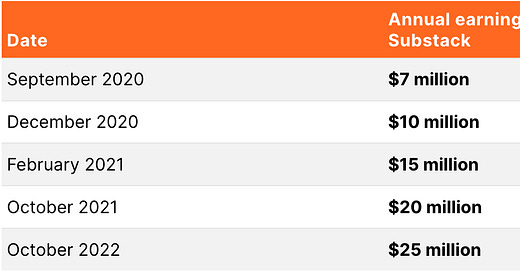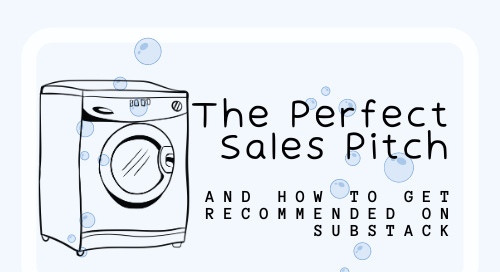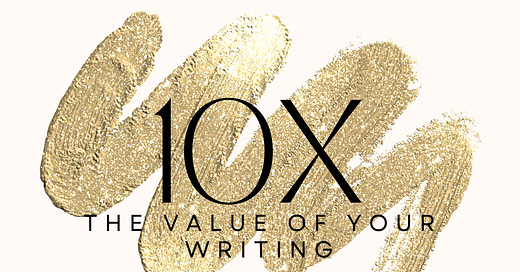

Discover more from Smarter Solopreneurs
7 Substack Superstars Share How To Grow Your Newsletter
A must-read for beginners and non-beginners.

If you’re any kind of solopreneur, Substack is where it’s at.
Your audience is already here, and it’s active as hell. People here read, subscribe to, support and even pay for great writing.
Substack has “millions” of readers, according to its co-founder Hamish McKenzie, and we all want to attract as many of them as possible.
But when you first join Substack, it may seem like you’re late to the party.
There are SO MANY Substacks. How do you grow yours as a beginner?
And what if you’ve hit a decent number, but you’ve stopped growing? Are you done?
In today’s One Person Business Success issue, I’ve curated the advice of some of the fastest growing and/or biggest Substackers so you can build a successful strategy that puts your writing in front of more readers and helps you grow.
Let’s dive in.
Write for yourself — Ava Bookbear
Substack, Bookbear Express, has over 24K subscribers and—here’s the kicker— over 1000 paid subscribers. That is an amazing conversion rate! So how does she do it?
“Substack was my journal, a place for uncategorized thoughts. Right from the beginning I thought it needed to have a theme. It didn’t have one. Two years later, it still doesn’t have one.
For a while, I thought it was going to be self-help, but that wasn’t quite right. All the advice I give is secretly advice for myself (“help-self”, see?). What’s worked for me is just to write about whatever is on my mind, and not worry too much about what category it falls under.” — Ava writes in this post.
I really like this advice because, in our desire to learn marketing and sell more, we tend to focus on what others want and forget to listen to our inner voice.
It’s there to tell you what’s valuable to you, and if it’s valuable to you, it will be valuable to others.
So, if you’re confused about your Substack topic or need more ideas for your newsletter, just notice what makes you tick and talk about that.
Write a Hero Post — Karen Cherry
shares amazing advice for new substackers in the PubStack Success newsletter. Something I learned from her was the secret power of a hero post. “I’m a huge fan of the hero post and have one on each of my publications. They generate more sign-ups than all my other posts combined.” Karen says, and she’s not the only one.
In her post “How to get more subscribers with a hero post”, she also mentions Tom Orbach’s experience.
“Tom Orbach of Marketing Ideas, says of his pinned post “People keep telling me that it’s the #1 thing they saw, and it’s the one thing that made them subscribe (since they easily understood what my newsletter is about and where it is going)”.
In short, a hero post is a post that sums up & illustrates the big idea behind your Substack. You can pin it so it stays on top of your home page. This way, every new visitor can easily understand what you’re about, which makes the decision to subscribe much easier.
Find your rhythm — Lenny Rachitsky
is the author of Lenny’s Newsletter — a newsletter with over 500K subscribers. It’s in the top 5 biggest Substack newsletters, and probably the biggest advice-type newsletter in the world. In his post “500 000”, he shares 10 lessons he learned from building a 500K subscribers newsletter.
While I recommend you read his entire post, my favourite part is this:
“A weekly cadence is a great starting point. People often start publishing at too fast a rate and quickly burn out. I can only sustainably write one great post a week. Crazies like Ben Thompson, Noah Smith, and Heather Cox Richardson can do this almost daily. Others can do it only monthly. All these routes are fine. Depending on your goals, even one incredible post a year is very valuable. The key is to find a cadence you can keep up for years.
Remember, quality + consistency = you win, and people don’t want more emails. They want better emails.”
What’s the schedule that will allow you to stay consistent and produce quality?
Spend more time on it — Michael Simmons
is the author of the Blockbuster Blueprint, a newsletter with 150K subscribers, and one of my favourite online writers. His devotion to deep research and attention to detail are super inspiring. In this post from November 2023, Michael announced that he’s going from sending 3 newsletters per week to sending 2, which perfectly aligns with one of the main pieces of advice he gives new writers: spend more time on your piece.
Statistics show that spending more time on an article or newsletter increases the time readers spend reading it.
Here’s how to spend that time so you increase the quality of your writing:
Spend more time researching your idea.
Spend more time structuring your piece so you can build a powerful argument.
Give yourself more time to write a messy first draft so you can include all your ideas.
Spend more time editing your final piece.
Use Notes — David Mcllroy
, the writer of the How to Write for a Living newsletter, recently shared how he grew his audience by 1400 subscribers in just two months. Impressive! The big piece of advice he shares is how instrumental posting on Notes was to his success.
“Somehow, I think this aspect of Substack has gone under the radar for a lot of people. My audience growth shot upwards when I started making regular use of the Notes feature,” David says.
Notes is the social media feature of Substack. It’s like your FB wall: a place to share your writing or just a thought, to “restack” your favourite reads and keep in touch with your favourite authors.
It makes sense that Notes would boost your number of subscribers, yet I agree with David that many writers miss out on its potential. I don’t know about you, but I plan to use Notes more this year.
Recommendations — Kristina God
A lot of people talk about the recommendations feature on Substack, but if you want to make the best of it, follow
. In Kristina’s Newsletter, she’s all about helping you grow your audience (on Substack and beyond), and her latest move is pretty awesome.Instead of just telling us to use the Recommendations feature (which allows you to get recommended by other Substack newsletters and gain subscribers on autopilot), Kristina gives us a chance to make the best of it in her latest project, a collaborative Substack Spreadsheet.
In short, you can include your publication in the spreadsheet, and it can be recommended by other authors who think your audience matches their audiences. In turn, you can also choose newsletters that would be interesting to your subscribers and recommend them.
Awesome idea, Kristina!
Alternatively, you can get in touch with writers you like and suggest a collaboration. Let’s help each other grow!
Use other platforms — Everyone.
If you’re a beginner and you’re only on Substack, let me save you from making a mistake I made: don’t just be on one platform.
Instead of wondering which one to choose, try a few and see which one works best for you.
All platforms have a different type of audience: Medium, X, LinkedIn, Instagram, YouTube. This means each platform gives you access to a different group of people.
Where can you find more of your people? Well, you can’t be sure until you try.
This doesn’t mean you should do it all, because you’d go crazy. But choose at least two more platforms and show up consistently.
Ava Bookbear says most of her new subscribers come from Twitter. For me, it’s Medium. I know Tom Kuegler is big on LinkedIn.
Substack is awesome, but don’t put all your eggs in one basket. Take your Substack newsletters, summarize them or cut them up to quotes, and post them wherever you can.
Note: other platforms don’t like to take readers away from in-platform action, so don’t post external links directly in your posts. Instead, post them in a comment.
I make $100K per year writing online. You can, too. Subscribe to One-Person Business Success below.
















All great advice here. I'm definitely trending more and more in the direction of writing for myself. I originally posed my newsletter under the self-help banner, but the more I write, the more I'm discovering that my newsletter is really just my own observations and discoveries in middle-age. I'm not afraid to make myself look like a clown at times. There's a certain kind of freedom in that, and I'm enjoying it so much more.
Sheesh this was nice Maya!
So much info, thanks for sharing!
I noticed a lot of my traffic comes from Medium!
I’m going to try and work on increasing my conversions there.